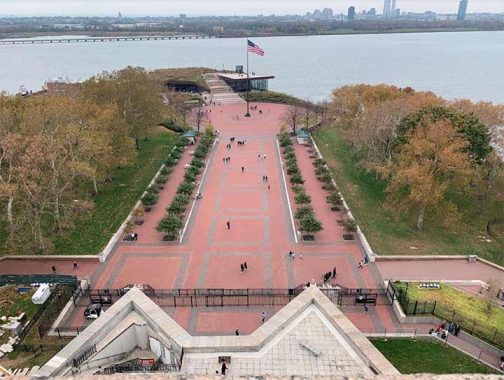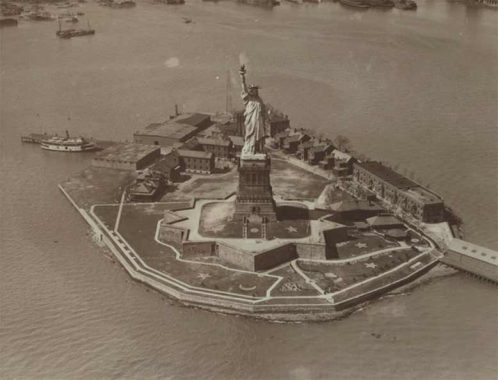
Ed. note: I haven’t been to the Statue of Liberty since a Cub Scout trip in 1965, and I remember exactly nothing, but Sergey has been there a bit more recently.
By SERGEY KADINSKY
Forgotten NY correspondent
AMONG the least “Forgotten” monuments in New York City is the Statue of Liberty, which appears on currency, passports, and postage stamps, as much a symbol of this country as the Old Glory, bald eagle, and Uncle Sam. This gift from France has stood in New York Harbor since 1886.

Below the statue designed by sculptor Frederic Auguste Bartholdi and engineer Gustave Eiffel is a pedestal designed by Richard Morris Hunt, the architect of the Metropolitan Museum. Perhaps the least known feature of this national monument is the 11-pointed star-shaped platform on which the pedestal stands. The museum on the western tip of Liberty Island has models of the rejected pedestal designs which were also designed by Hunt.

Prior to the arrival of this “new colossus,” this platform was a fort built to defend the harbor against the British ahead of the War of 1812. The invasion never happened, but its connection to the war is its namesake, Colonel Eleazar Wood, who was killed during the siege of Fort Erie in Ontario, Canada in 1814. Along with Fort Gibson on Ellis Island, Castle Clinton, and Fort Jay on Governors Island, Fort Wood contributed to the security of New York Harbor. After this war, it served as a station for quarantines, recruiting, and as a depot with the city’s shortest railway. The eastern gate to the fort dates back to the pre-statue period, presently used as an exit in emergencies.

On my visit to the statue, I only sought to document the forgotten elements of this world famous landmark. Atop Fort Wood, there is a staircase descending from the platform where an arch from its military period is visible. It was built during the expansion of the fort in the 1840s. It is a reminder of what the fort looked like before the statue was built, when the interior of the star had a courtyard.

From the top of the pedestal looking down, the exposed arch is seen as a cutout in the platform. At the island’s western tip is its newest building, the Statue of Liberty Museum with its green roof of native plants.
A pair of fancy doors with relief sculptures greets visitors into the statue. In a fort, the main entrance is the sallyport. Following the construction of the museum inside the fort, the sallyport was raised to nearly the height of the fort’s wall. The fort also has a smaller door on its eastern side. That door is still there, predating the statue atop the fort. A report on the history of the fort published in 1956 shows plans for the sallyport and the second entrance tunnel on pages 39 and 40.

For visitors who accessed the statue using its eastern entrance, they walked through a tunnel that was used by soldiers at Fort Wood. In 1968 the National Parks Service conducted a photo survey of Liberty Island and took a photo of this tunnel that is now an emergency exit.

Earlier in that decade, the fill underneath the platform was dug up and developed as the American Museum of Immigration, fitting with the narrative of this statue greeting newcomers as they sailed into the harbor. After this museum relocated to Ellis Island, the space was redesigned with displays on the history of the statue. Prior to the statue, the interior of the fort’s walls had the terreplein, a raised surface where the cannons stood. The courtyard was on ground level at the center of the fort. For any possible buttons or coins in this fill, the National Parks Service conducted an archeological survey of it in 2013.

Prior to this excavation, the interior of Fort Wood’s walls were last seen in 1885 when the statue was under construction. Artist Willard Poinsette Snyder made this illustration of the work underway. The recently constructed Brooklyn Bridge is in the background.
(The inset shows Liberty designer Frederic Bartholdi)

An undated photo from the 1860s shows cannons at the ready on Fort Wood’s terreplein. This is a stereoscopic photo, designed to fit into a binocular device for both eyes to see. The parapet in front of the cannon is accessible to the public today.

A photo from 1890 shows a soldier guarding this tunnel inside the fort. Nowadays, visitors enter through a screening pavilion into a gray concrete lobby that resembles a mausoleum interior. They can either see the history exhibits, wait for the elevator to the pedestal, or hike 215 steps to get there.

At the top of the pedestal, visitors can look up and see Eiffel’s frame inside the statue. A spiral staircase ascends 162 steps to the crown, which requires reservations months in advance. Under the present building codes, Lady Liberty is not in compliance because she has only one set of stairs connecting to her crown. Fortunately she is grandmothered by the city but the ladder to its highest point, the torch, was closed to visitors in 1916.

Next to the gate for the spiral stairs is a piece of an older staircase with wrought iron banisters from a more decorative period in architecture.

Looking back to that time, the lawn around Fort Wood was decorated with stars and crescents in the 1930s, and the interior of the fort’s platform had a mound around the pedestal. It was replaced with a set of balconies and stairs in the 1960s, with the museum constructed beneath them.
Although the star-shaped fort became obsolete by the end of the Civil War, the island’s use by the military continued through 1937. Through this period the statue welcomed visitors while cannons stood at the tips of the star and on the sea wall. By 1944 the barracks were gone and the entire island became a park. Bedloe’s island was renamed Liberty in 1956, its name later extending to the state park behind the statue and the airport in Newark. For visitors unfamiliar with the site’s past, the 11-pointed star appears to have been built for the statue but it has a fascinating history of its own.
You can learn more about Liberty Island by visiting each of the hyperlinks posted in the essay above. Although it is our first essay on Liberty Island, Kevin and FNY correspondent Christina Wilkinson have been to nearby Governor’s Island in the past:
Christmas on Governors Island, 2004
Sergey Kadinsky is the author of Hidden Waters of New York City: A History and Guide to 101 Forgotten Lakes, Ponds, Creeks, and Streams in the Five Boroughs (2016, Countryman Press), adjunct history professor at Touro University and the webmaster of Hidden Waters Blog.
As always, “comment…as you see fit.” I earn a small payment when you click on any ad on the site. Take a look at the new JOBS link in the red toolbar at the top of the page on the desktop version, as I also get a small payment when you view a job via that link.
11/18/23


15 comments
When I first heard that the statue was going to have a major overhaul in the 80s
I was full of hope that at last,theyre going to finally make the torch accesible,but as
usual its “No,its too dangerous….you might hurt yourself….Its for your own good…
maybe some other time….
They possibly feared people would want to use it for suicide or as a sniper perch, I’m guessing?
For some reason, I always felt what was at the base was a remnant of something that might have predated the very statue itself.
The arm was closed to the public after a WW I era explosion which weakened it.
The closing of the Torch is reported to be the result of the July 16, 1916 explosion on nearby Black Tom (now a part of Liberty State Park). Although the United States was still a neutral in the Great War (World War I), we allowed the sale of munitions to the Allied Nations (Great Britain, France, Italy). The Central Powers considered that to be aiding their enemy and allowed them to take action against it. On that early Sunday morning, German agents set off explosions that destroyed the munitions depot, but also shattered windows across Lower Manhattan and Jersey City. Shrapnel damaged the Statue of Liberty, and structural concerns caused closure of the arm. This is one of the largest non-nuclear explosions in history. Current value of the damage (in 2023 dollars) is about $1.25 trillion. The damage to Lady Liberty (in 2023 dollars) was about $2.5 million.
And then there was the 2020 Beirut explosion, which produced the best *literal* wedding photobomb of all time:
https://www.youtube.com/watch?v=_L7SlqDtRnc
Speaking of the arm and the torch, there are some interesting stories about them. Before the actual statue was built, the arm was used as part of an ice cream stand around the US Centennial. Meanwhile, the flame on the torch was replaced in 1986 with the one you see now after celebrating the statue’s centennial, though you can still the what the original flame looked like in the museum where it has been ever since.
Oh,if the torch was built like a tank you still wouldnt be able to go in it,so why did
I even bother.
One who did was William Gaines,publisher of Mad magazine, who one night along
with some cronies from Mad motorboated out to the statue,bribed a guard and went
up in the torch.But due to Gaines ample fanny he got stuck on the ladder.Theres a
photo of him up there and by his expression seems to think its all a big funny.Crowbars
and chain falls were probably used in the extraction and it is said that when he finally
went POP! you could hear it all the way to Hohocus.
My late father recalled the Black Tom explosion as a kid, being knocked out of bed at his home on Classon Ave., Brooklyn. He said that store front windows were shattered, as well.
Nice! Can we some Forgotten NY on the National American Indian Memorial of which ground was broken in Staten Island, but never completed?
Where was it?
Groundbreaking was held in Fort Wadsworth in 1913, very close to where the Staten Island tower of the Verrazzano-Narrows Bridge now stands. President Taft even attended the ceremony:
https://en.m.wikipedia.org/wiki/National_American_Indian_Memorial
There is a fascinating book called “Keeper of The Flame” by William C.Armstrong about Charlie DeLeo who was the caretaker of the statue for many years.
Despite the structural concerns, it sure was OK to drop Big Jim Coburn onto the torch for that extraordinary scene at the beginning of “The President’s Analyst”
(actually comes near the end of this clip, starting at ~3:10):
https://www.imdb.com/video/vi2024390681/?ref_=ttvi_vi_imdb_1
Oh,thats nice,James Coburn can go up there but not you and me.
Some animals are more equal than others